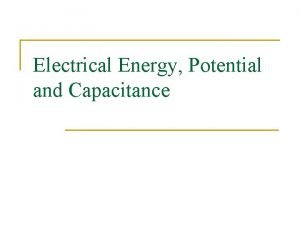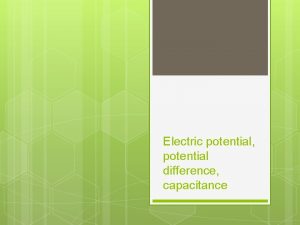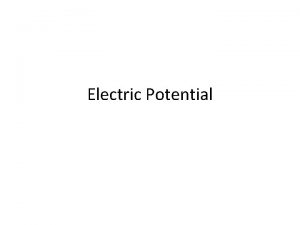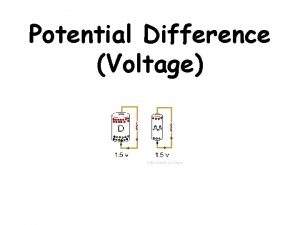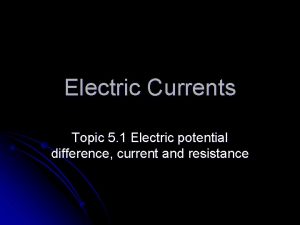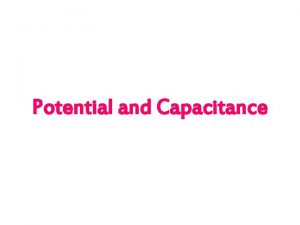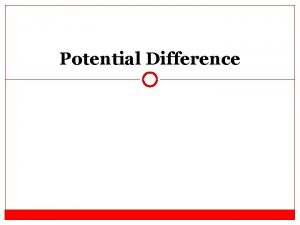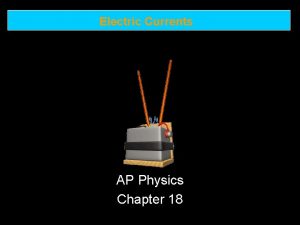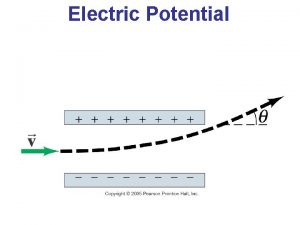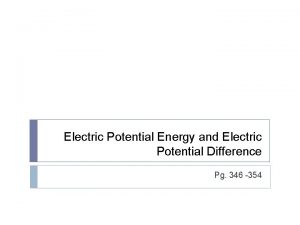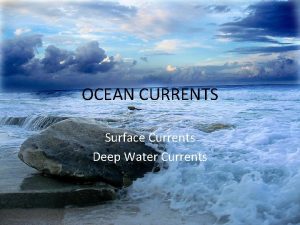Electric Currents Topic 5 1 Electric potential difference


























- Slides: 26

Electric Currents Topic 5. 1 Electric potential difference, current and resistance

Simple Circuit • What does a simple circuit include? • Circuit implies a flow. What is flowing? • How do you know there’s a transfer of energy? • Can we see any of this?

Analogy

Advanced Analogy Energy Added to the System Energy Removed from the System

Definitions • What are charges? • How do we use charges to produce potential movement? • What happens when there is a charge in the middle?

Energy between metal plates • What needs to be done to move a negative charge from the red to blue plate? • What happens to the charge when it’s at the blue plate? • What happens when it’s released?

Potential Difference • Energy needed to move a charge from A to B


cell ☺ ☺ ☺ energy ☺ electron ☺ ☺ lamp ☺ ☺ ☺

Current • What is current? • How would we measure current? Conventional Current Electron Flow

Resistance • What is electrical resistance?

Ohm’s Law

Ohmic vs Non-Ohmic Resistors

Back to the Electric Circuit • Where does the energy come from in an electric circuit? • Where does the energy go? • What determines the amount of energy that is ‘taken’? • What is carrying the energy?

Definitions • Charge, Q • Current, I • Potential Difference, V (Voltage) • Resistance, R • If units of charge are coulombs [C], derive the units for I, V, and R

Definitions • 1 coulomb = 6 x 1018 electrons of charge • Current, I • Potential Difference, V (Voltage) • Resistance, R • If units of charge are coulombs [C], derive the units for I, V, and R

Definitions • 1 coulomb = 6 x 1018 electrons of charge • Current = Charge / Time • Potential Difference, V (Voltage) • Resistance, R • If units of charge are coulombs [C], derive the units for I, V, and R

Definitions • 1 coulomb = 6 x 1018 electrons of charge • Current = Charge / Time • Potential Difference = Energy / Charge • Resistance, R • If units of charge are coulombs [C], derive the units for I, V, and R

Definitions • 1 coulomb = 6 x 1018 electrons of charge • Current = Charge / Time • Potential Difference = Energy / Charge • Resistance = Voltage / Current or

Units •

The electron volt (e. V) • One electron volt (1 e. V) is defined as the energy acquired by an electron as a result of moving through a potential difference of one volt • 1 e. V = ? J

The electron volt (e. V) • One electron volt (1 e. V) is defined as the energy acquired by an electron as a result of moving through a potential difference of one volt • 1 e. V = 1. 6 x 10 -19 J

Inside the wire

Wire = Resistor • What happens when the electrons collide with the atoms? • What happens to the atoms when the wire is at a higher temperature? • How does this affect the resistance of the wire?

Power Dissipation • •

In summary
 Electric potential
Electric potential Equipotential lines
Equipotential lines Units of electric potential energy
Units of electric potential energy Electric potential inside non conducting sphere
Electric potential inside non conducting sphere Potential energy in uniform electric field
Potential energy in uniform electric field What is deep current
What is deep current Electric potential and potential energy
Electric potential and potential energy Electric field equation
Electric field equation Electric field from electric potential
Electric field from electric potential Market potential and forecasting
Market potential and forecasting What is electric potential
What is electric potential Electric potential difference
Electric potential difference Electric currents and magnetic fields
Electric currents and magnetic fields Visualizing magnetic field
Visualizing magnetic field Difference between potential difference and emf
Difference between potential difference and emf Clueing topic sentence
Clueing topic sentence Narrow
Narrow Osmotic potential vs water potential
Osmotic potential vs water potential Calculating water potential
Calculating water potential Understanding water potential
Understanding water potential Graded potential vs action potential
Graded potential vs action potential Decremental graded potential
Decremental graded potential Graded potential definition
Graded potential definition Graded potential vs action potential
Graded potential vs action potential Graded vs action potential
Graded vs action potential How to find pressure potential
How to find pressure potential Source of bioelectric potential is dash in nature
Source of bioelectric potential is dash in nature














